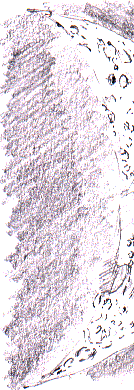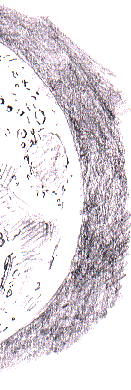 |
The TerminatorSaturday 30th December 2000, West Yorkshire |
![]()
![]()
![]()
![]()
![]() Nature
Diary Rocks
History
Workshop
Links
Home Page
Nature
Diary Rocks
History
Workshop
Links
Home Page
![]()
  |
THE TERMINATOR is the line between night and day as experienced on the Moon. From the Earth we see it as the edge of the crescent, between light and dark. The lunar day is 27.3 Earth days long. Since this is equal to the time it takes the Moon to make an orbit of the Earth, we always see the same side, or more or less the same side - there are slight wobbles in the rotation - facing towards us. The terminator isn't a regular curve. Through a telescope you'll see that higher mountains catch the Sun's rays long before the adjoining valleys, making for an irregular boundary. |
A Lunar Tour
| Imagine the Moon as a clock face. If we start at just gone 'twelve o'clock' you'll see a small crater, close to the terminator; that's Arnold. Come down to about 2 o'clock and there are twin craters alongside each other, like a pair of startled eyes; Hercules and Atlas. The larger dark patch around 3 o'clock is Mare Crisium, 'the Sea of Crises'. Its smooth surface is broken by a small crater called Picard (no relation to the Star Trek captain). Picard lies near the western (left) 'shore' of the 'sea', but barely shows on my sketch. |
  |
One more sea; at five o'clock, just appearing across the terminator, that's Mare Nectaris - you'll be getting the hang of this by now, so I won't translate.
Finally, down there in the Southern Highlands at five o'clock can you see a tiny crater within a larger crater; that's Pitiscus (apparently Pitiscus studied trigonometry).
Formation of the Maria
Of course the Maria are not, and never have been, true seas. Water played no part in their formation. As far as I know, as yet there is no confirmation of any water on the Moon, although I remember reading reports of what might have been water vapour being spotted in a crater a year or so ago, so who knows?The maria are basins that have been filled with lava. Those lava flows have since been pulverised by meteorites. One theory of Mare formation suggests that in the earlier stages of the formation of the solar system, some three to four billion years ago, asteroids collided with the newly crusted over Moon and molten lava flowed out from the huge impact craters.
Any molten material in the Moon today must lie close to its core.
Most of the 'seas' are linked to one another and all but a couple of smaller examples are on the side which faces Earth. Mare Crisium is unusual in being a separate 'sea'. It's thought that a mass of dense igneous rocks underlies it. This hidden mass is dense enough to cause irregularities in the orbits of spacecraft as they pass over it.
Today in the Valley
Despite the sun, snow still covers the landscape. The low sun gives a warmth to the colour of bare trees, but the temperature doesn't rise much above freezing and it's set to plummet again overnight. Wood Pigeons and Crows are about all we see on a short walk.![]()
Richard Bell,
wildlife illustrator
E-mail; 'richard@willowisland.co.uk'
![]() Next page
Previous page
This day last year
Nature Diary
Home Page
Next page
Previous page
This day last year
Nature Diary
Home Page
![]()